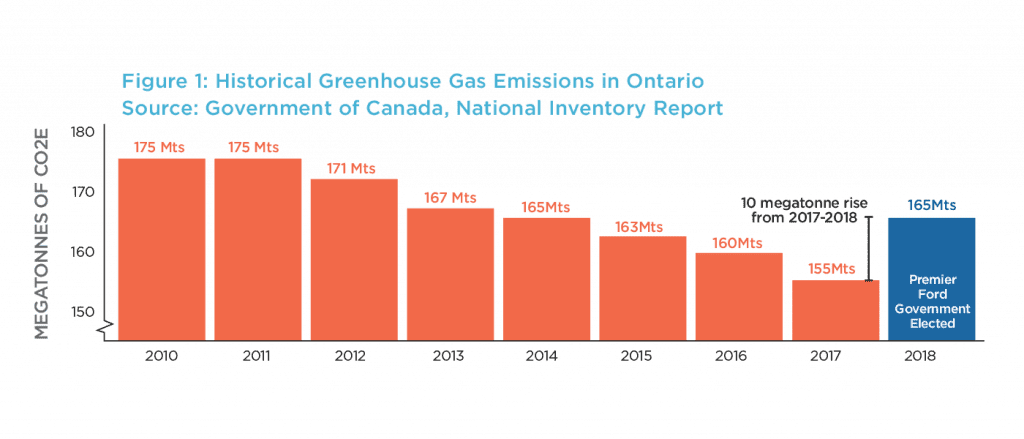On November 27, 2020, Minister Yurek outlined his government’s progress on its Made-in-Ontario Environment Plan, and claimed to be lowering greenhouse gas emissions. Our new report tells a different side of the story.
Yours to Recover: A Progress Report on Ontario’s Climate Change Actions shows that Ontario’s emissions are actually rising as a result of government inaction. After two years, the Ontario government has largely ignored its own Made-In-Ontario Environment Plan and failed to take meaningful action to reduce greenhouse gas emissions. What little progress has been made is in areas with the least potential for reducing emissions, while actions which could to deliver significant emissions reductions have been overlooked.
WATCH SARAH BUCHANAN, ONTARIO CLIMATE PROGRAM MANAGER TALK ABOUT THE REPORT

What’s actually been done to fight climate change?
Ontario’s Environment Ministry likes to tout a few accomplishments from its Environment Plan to show they’re taking action. To be fair, Ontario has nipped around the edges with programs like its Emissions Performance Standards pricing system for industrial polluters, and a plan to slowly increase renewable content (mostly ethanol) in gasoline from 10 per cent to 15 percent over the next decade. But by the time these programs were finalized, they’d been delayed, weakened, or debunked as credible ways to reduce emissions.
The Environment Plan’s modelling has never been officially updated, despite being thoroughly discredited by the Ontario Auditor General in 2019. Her estimates show that these two programs would only achieve about 1 mega tonne each of reductions – that’s about one tenth of the emission reductions Ontario needs to meet its 2030 target to reduce emissions by 30 per cent. That leaves about ninety percent of their promised reductions unaccounted for. Ontario can’t meet its 2030 target at this rate – and may not reduce emissions at all.
At the same time, the Province is ignoring the most effective climate change solutions from its plan, like natural gas conservation and energy efficiency. This fact was front and centre in the Ontario Auditor General’s annual environmental report this year. She pointed out that taking no action to reduce emissions from buildings – responsible for about a quarter of Ontario’s total emissions – is a huge oversight that will hold Ontario back from meeting its climate target.
Ontario is also MIA on its biggest source of carbon emissions: transportation. There are no plans to support a transition from gas-powered cars and trucks to electric vehicles, despite a claim in the plan that 16 percent of Ontario’s emission reductions will come from switching to low carbon vehicles like electric vehicles.

Can Ontario fight climate change with a green recovery?
Ontario has promised to improve its Environment Plan to show how they will keep their climate change promises. This is a big opportunity to integrate solutions to help Ontario’s economy recover from COVID-19. Governments of all political stripes have introduced green recovery plans of some kind, even Conservative governments like the U.K. and our next door neighbours in Quebec. Will Ontario do the same?
The province’s COVID-19 economic recovery plans will make climate change worse by accelerating destructive, high carbon projects like highways and suburban sprawl. Ontario’s COVID-19 Recovery Bill amended over 20 provincial statutes. It “streamlined” (i.e. removed crucial parts of) the Environmental Assessment Act, allowing infrastructure projects like highways to race ahead without the same level of scrutiny. The Act was exempted from public consultation, which violates the Environmental Bill of Rights, and is now facing multiple legal challenges. The Bill also enhanced the power of Minister’s Zoning Orders (MZOs) which have already been used by this government dozens of times to allow building on protected wetlands and farmland.

Early glimpses of new climate programs are not promising. Ontario is working on a Hydrogen Strategy to reduce emissions from fuels. Hydrogen has a lot of potential as a clean fuel when it’s made with renewable electricity – something Ontario still has despite the Ford government’s cancellation of hundreds of renewable energy projects. But the strategy has few details, no targets to reduce greenhouse gas emissions, and no estimates of potential emissions impact.
Hydrogen is currently most effective when used to decarbonize industrial processes like making steel and cement, which are really hard to decarbonize any other way. It’s least effective when used to heat homes and power vehicles, since existing clean technologies can do this at lower cost. But the discussion paper for Ontario’s hydrogen strategy seems to include a strong focus on using hydrogen for heat.
The pilot project announced alongside the hydrogen strategy will spend about $5 million to mix hydrogen into a natural gas network to heat homes in Markham. The end mix will only be up to 2 per cent hydrogen – the rest is natural gas, a fossil fuel. But an electric heat pump, a clean technology that can heat homes directly with low carbon electricity, is currently languishing in Ontario’s Environment Plan with no government support. Instead of using electricity for heat pumps, Ontario is paying millions to use this same electricity to make hydrogen and then mix tiny amounts of it into fossil fuels for home heating. This will pollute much more than a heat pump. The final strategy should focus on more effective ways to use hydrogen to reduce greenhouse gas emissions.
So how can Ontario improve their climate change plan and stimulate economic recovery? The smart move would be to implement forgotten Environment Plan commitments with big potential for jobs and the economy, like natural gas conservation and energy efficiency programs, and programs to help shift people from gas-powered cars and trucks to transit, electric vehicles, cycling, and walking.
In many cases, greener stimulus is better for the economy. Evidence from post-2008 recovery shows that more job hours were created per dollar for public transit projects than for highways. And think of all the people-power needed to install energy-efficient windows, insulation, upgraded furnaces, transit projects, or charging stations for millions of electric cars. These skills will only grow in demand as the world shifts to a low-carbon economy, so it also gives Ontarians training and skills to get ahead in a growing and green jobs market.
So far, the Province has not pursued a green recovery or evidence-based climate solutions to meaningfully reduce greenhouse gas emissions. We hope to see an improved Environment Plan in the future that shifts in this direction. Otherwise, Ontario’s 2030 climate target will be a total write-off.
Stay up-to-date on environmental issues. Join our email community









